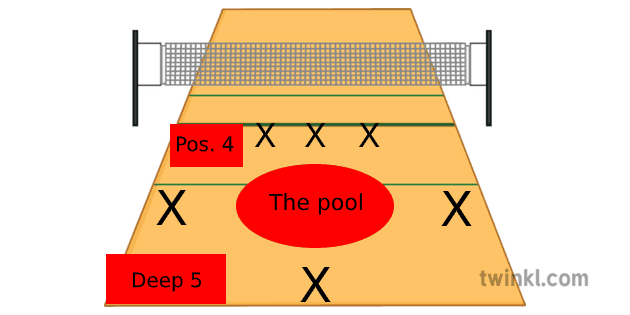Hitters have a lot of different options in their offensive strategies. They can spike, tip, tool or swipe the ball. A smart or strong hitter is often the go-to scoring method for a team. That does not mean there aren’t any other ways to score. For instance, what offensive options does the setter have? Let’s look at an important skill to learn as a setter that can score some points.
The setter dump is an offensive play intended to be a surprise attack from the setter on the second ball contact. Using deception, the setter jumps to set with two hands and pushes the ball over the net with one hand. The dump can only be done when a setter is in the front rotations.
Learning this skill is an important step in the development of a good setter. That being said, it really is not an easy skill to master. Join me as I explore further different methods or techniques of dumping the ball, what the rules are around this play, and learn when is a good time to dump as a setter. That last part could be useful for blockers as well, as it is part of their job to read and react to a setter dump.
A Prerequisite For Your Setter Dump

Before we go deeper you must know some fundamentals to fully understand how to properly execute a setter dump.
To perform a great dump, a setter must already possess the skill of jump setting. This means that you are able to set the ball while in the air. The reason why it is a prerequisite is that being able to have your hands already above the height of the tape will ensure that the dump is a real threat and leaves your opponents no time to react. You’ll need to be over the net to be able to dump the ball in a downward motion. Not doing so will greatly diminish the effectiveness of your dump. If you’d like to know more about jump setting, watch this video from Elevate Yourself on YouTube.
Once you are able to jump set, you can explore further the techniques of the dump.
Be Discrete
Going forward, I would like you to always keep in mind that the most important factor to determine a great dump is deception. As a setter, it is crucial that you be as discrete and deceptive as possible. A successful dump requires the element of surprise, it needs to be an unexpected move from your part. How do you do that?
Simple. As part of the job of the setter, you should always hide your intentions, regardless of the situation. If you give away signs to your opponents about how you play, they will be able to react much quicker and stop more of your attempts at scoring. That goes for setting and the dump. Now that we’ve covered some basics, let’s get to the techniques.
How – 3 Different Ways to Dump
There are many different ways to dump a ball in volleyball. In my experience in both women and men volleyball, I could find three different techniques to dump the ball. To know which one to use, a setter will have to find which technique better suits their playstyle and abilities. So, let’s get into it, shall we?
Right-Hand Dump
To do a right-handed dump:
- Jump with both hands ready, as if you were going to jump set.
- Once the ball reaches the vertical plane of your head, turn your right hand to prepare for the contact.
- When the ball comes in contact with your right hand, push the ball through your body and behind you with your arm. Aim for the ball to land in the front left corner of the court, or position 4.
Evidently, this dump refers to the use of your right hand. Since the majority of the population is right-handed, many will prefer this technique. The problem is that on average it is a weaker method of doing the dump. The reason why it is weaker is that it is a less aggressive method of dumping in general.
Left-Hand Dump
To do a left-handed dump:
- Jump with both hands ready, as if you were going to jump set.
- Once the ball reaches the vertical plane of your left hear, lower your right hand and reach with your left hand to prepare for the contact.
- Attack the ball when it comes in contact with your left hand by pushing the ball over the net with your arm aggressively. Have your palm face where you would like to aim. Ideally, you aim for it to land in the center of the court or where a hole presents itself.
- To give a downward motion to your dump, make sure your fingers are contacting the top of the ball.
The left-handed dump is the go-to technique for dumping the ball. There are some important reasons why it is the case. A left-handed dump has the advantage of being a lot more deceptive. By jumping for the set you are already in position ready to dump, you only need to lower your right hand and push the ball over with the left hand. The main issue is that many players are not as confident in their ability to use their non-dominant hand. The dump does require good eye-hand coordination, more difficult to achieve with your non-dominant hand. My only recommendation, practice, practice, practice. Your efforts will pay for themselves in due time.

The “Set-Over”
This bonus technique comes to the rescue of our less athletic setters. The set-over is technically a setter dump but it really does not compare to the techniques mentioned above.
The set-over is, well, literally a very short and tight set over the net. It is meant to barely go over the net and the opposing blocker to land directly behind them or in the center of the court. To get a better understanding, consider checking the short video below.
Where to Dump
A great dump is not only well-executed but is also smartly placed. When dumping, you must know where to send the ball. I’ve covered the technique already but you should know that you need to be smart in your placement of the ball if you want to score. Generally speaking, I would recommend you dump the ball wherever holes present themselves, and here are three holes that show up often.
- The Pool
- The pool is a reference to the center of the court, where no one is usually defending. The center area is where the defenders will swim to try and save the ball you will dump there. If no blocker is trying to prevent you from dumping, this is a prime area to aim at.
- Deep 5
- Aim for the deep corner of the court where no one expects you to push the ball on the second contact.
- Position 4
- The left-front corner, or position 4, is a very rarely defended area since there is usually a blocker to prevent you from aiming there. When you dump, if you have no blocker, you should go for it.

When to Dump
To score with the dump, a setter must be patient. There exists the right time to dump and you need to wait for it. Here are some signs to identify a good time to dump.
When It Is Obvious, Set It Instead
Think of setting and dumping as baits for the opposing blockers. It is important to use this metaphor to your advantage. As a setter, it is your job to distribute the ball to keep the opposing blockers aware of all the options available to you. The more options there are, the more likely they are to bite the wrong one. That is why a good pass is so important, but also why you should set when a dump seems like an obvious choice.
When an opposing blocker jumps when you jump set a ball that is tight to the net, forcing a set will allow your hitters more space when hitting. It will also play with the head of your opponents.
When the Fish Is Already Baited
When setting, you should be aware of the opposing blockers. A great time to dump is when the opposing blockers have been baited to another hitter making his approach. For example, if your middle hitter is ready to jump for a quick attack and is being covered by two blockers, that is a perfect time to dump. No one will have time to react to your attempt.
Remember that you always have a choice as a setter and that deception is your biggest ally to score points. Be aware of your opponents, exploit their weaknesses, and keep them guessing as much as possible.
Rules for “Dumping”
Before I concluded this article, I would like to cover some important rules you should know about the dump.
Back-Row
In my opening answer, I’ve described how the dump can only be done within the rules of volleyball when the setter is in the front rotation. That is true. Since the dump is classified as an offensive play, it is deemed a fault when a setter finds themselves in a back rotation and completes a dump.
According to rule 13.3.3 of the FIVB Rulebook of 2019, a fault has been committed when: A back-row player completes an attack hit from the front zone if at the moment of the hit the ball is entirely higher than the top of the net.
Ball-Handling Errors
As a volleyball player, you should already be familiar with ball handling errors, such as a lift, carry or double touch. When a setter completes a dump, they must be absolutely careful to not lift the ball with the palm of their hand nor carry the ball by almost holding it. It can be a very fine line to tread but it is possible that a referee sees your dump as a ball-handling error. So, be aware of how long your contact with the ball is and where do you contact the ball. You should try to dump by always reaching for the top part of the ball as it will help give your dump a downward motion, making it more likely to score.
